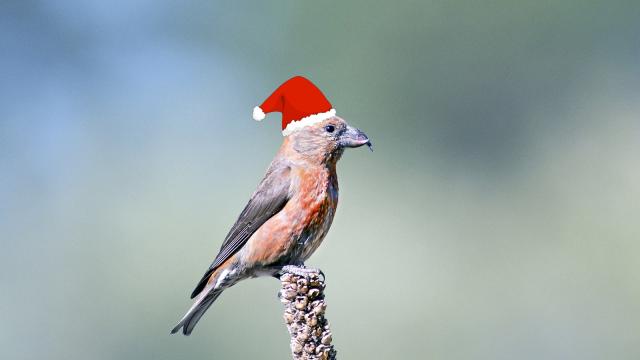Since taking up birding in earnest, I’ve started noticing the birds that appear on Christmas merchandise like stockings, cards, and ornaments. And I think we can do better.
I think that the red crossbill should be the Official Christmas Bird.
What’s a red crossbill? Well, think about a cardinal. Make it smaller, and brick red or dull yellow instead of bright red. Get rid of the cardinal tuft and mask, and make the beak black. Now make the upper and lower mandibles cross over one another at the tips, as if the bird had an underbite. You’ve ended up with a very good and very strange creature.
Christmas already has symbolic birds, most frequently the European robin: a small, orange-faced-and-breasted bird that lives in Europe, parts of western Asia, and North Africa. It’s especially popular in the United Kingdom. In the United States, where there are only two records of European robins, Christmas merchandise often comes adorned with the northern cardinals that stick around much of the eastern half of the country through the winter.
These species’ connection to Christmas is that they’re common, red, and people notice them in the wintertime. But in this increasingly connected world, one where we’re constantly reevaluating the old in favour of the new, I think it’s time to ditch these birds in favour of something seen on both sides of the Atlantic, tied more closely to the winter, and frankly, more interesting. That makes the red crossbill perfect.
Red crossbills, also called common crossbills, live throughout the northern hemisphere, and their peculiar crossed bills derive from an evolutionary arms race with the evergreen tree cones whose seeds they eat. That means they typically live in places where trees like pines, spruces, and firs are common — cooler or mountainous places, for example. During the winter, if there aren’t enough cones, they’ll head elsewhere to find more cones to eat — they even breed during the winter if they find enough food. Loud groups of crossbills chatter and hang acrobatically on their cone feasts, sometimes moving around with their bills like parrots. Males will collect seeds to feed nesting females and their babies.
You might wonder what makes this a Christmas bird any more than a northern cardinal or European robin. Well, the males are red, which seems to be a requirement, and they thrive during Christmastime. They’re a symbol of togetherness, giving, family, and getting rowdy. They’re forever tied to the evergreen conifer trees we call Christmas trees. And yes, they’ve been found near Jerusalem, so you could probably make up some weird folk tale about crossbills and Jesus.
You might be wondering what authority I have to make such a decision. I have absolutely none. I eat Chinese food on Christmas, a day on which I am presently working. I’ve only been a birder for about a year and a half. I just really like red crossbills and thought this would be a nice idea. Feel free to completely ignore this idea — but I’d love a red crossbill on a stocking next year.
